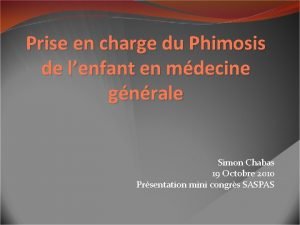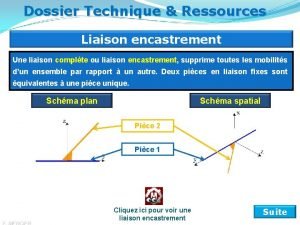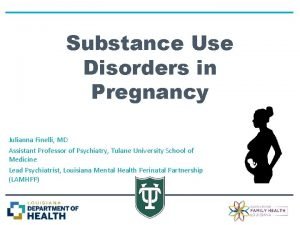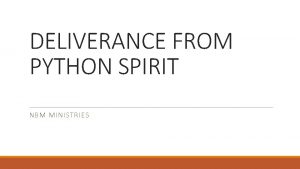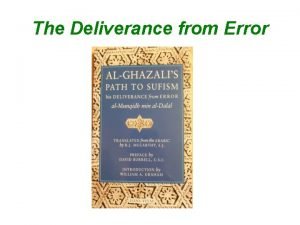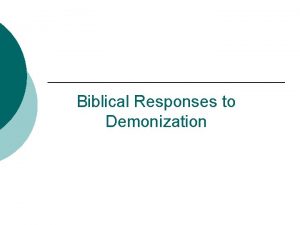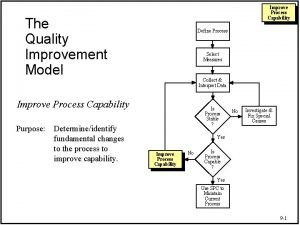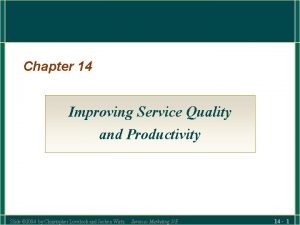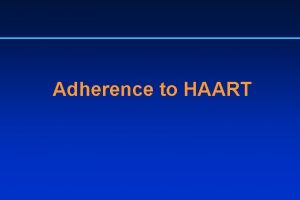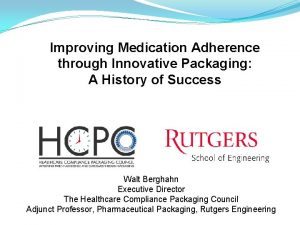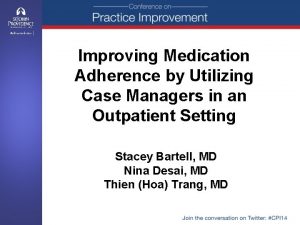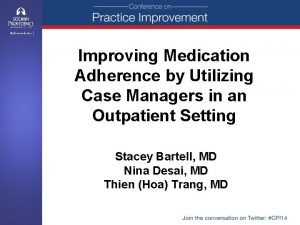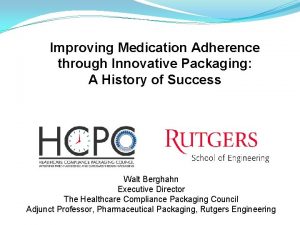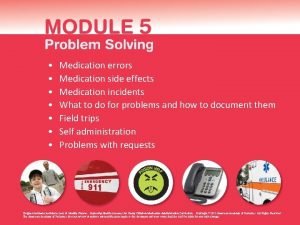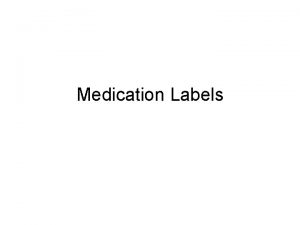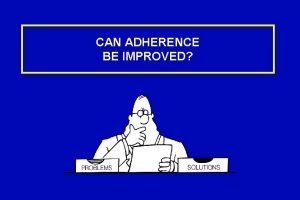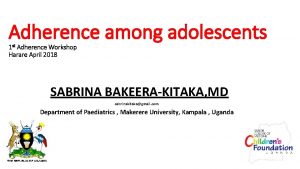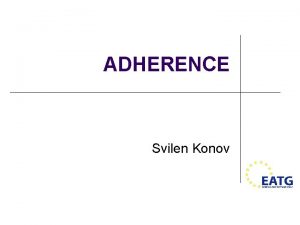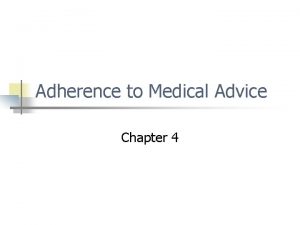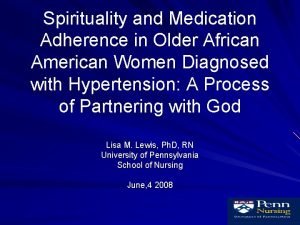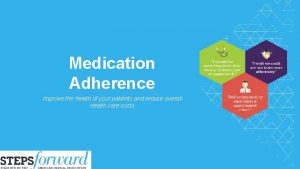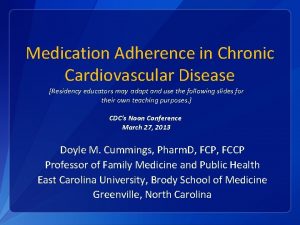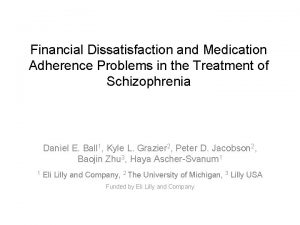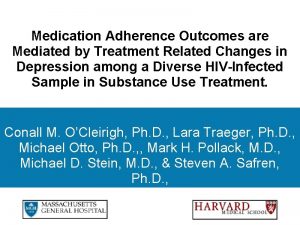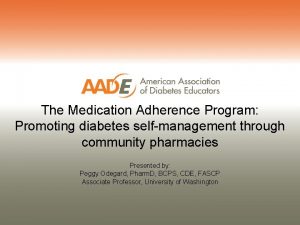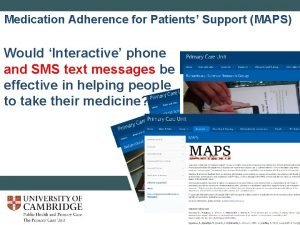Medication Adherence Improving Home Medication Deliverance Dr Julianna


































- Slides: 34

Medication Adherence – Improving Home Medication Deliverance Dr. Julianna M Kula, Pharm. D Pediatric Hematology/Oncology/SCT/Investigational Clinical Pharmacist Lucile Packard Children’s Hospital at Stanford November 4, 2014

Objectives § Discuss the importance of drug adherence, specifically compliance in home regimens § Define orphan drug and explain how mercaptopurine is classified under the Orphan Drug Act § Address how the new mercaptopurine formulation effects caregivers both in the hospital and at home § Revisit important points to remember when administering mercaptopurine § Evaluate other common home regimens

Patient Case § RF is a 5 year old female with standard risk ALL currently being treated on COG protocol AALL 0932 in Maintenance. She arrives in the clinic for her monthly chemotherapy and PE. While in clinic her mother mentions that her outpatient 6 MP prescription that she just picked up from the pharmacy looks different. She also states that the pharmacy informed her that the drug was now commercially available. She would like to further discuss with you what the very helpful pharmacist counseled her on.

Definition: Drug Adherence § Early definition: “the extent to which the patient’s behavior coincides with the medical or health advice” § More recent expansion: “active, intentional, and responsible process of care, in which the individual works to maintain his or health in close collaboration with health care personnel” § Those who take 80% to 109% of their prescribed regimen § Nonadherence: “when the failure to comply is sufficient to interfere appreciably with achieving therapeutic goal” Tebbi, Cameron. Treatment Compliance in Childhood and Adolescence. Cancer. 1993; 71: 3441 -3449. Pritchard, Michelle T. et al. Understanding medication adherence in pediatric acute lymphoblastic leukemia: a review. Journal of Pediatric Hematology Oncology. 2006; 28: 816 -823.

Impacts: Non-adherence § § § Misjudgment of medication as ineffective Ordering of unnecessary diagnostic tests Use of alternative treatments Modification of medications Bias assessment of a given experimental treatment regimen, resulting in an erroneous conclusion § Relapse in disease state Tebbi, Cameron et al. Compliance of Pediatric and Adolescent Cancer Patients. Cancer.

Non-adherence and Relapse § Majority of children with ALL enter remission after induction § 20% relapse in 5 years § Low erythrocyte levels of 6 MP metabolite (thioguanine nucleotide) correlate with relapse § Significant inter-patient thioguanine nucleotide variability has been observed § These results could be due to failure in adherence to home regimens Bhatia, Smita et al. Nonadherence to oral mercaptopurine and risk of relapse in hispanic and non-hispanic white children with acute lymphoblastic leukemia: a report from the children’s oncology group. Journal of clinical oncology. 2012; 30: 2094 -2101.

Assessing Adherence § Self-reporting § Drug Assays § Microelectronic Monitoring (MEMS) Tebbi, Cameron et al. Compliance of Pediatric and Adolescent Cancer Patients. Cancer.

Self-Reporting Noncompliance by Chemotherapy Agents Over the Course of Therapy 2 Weeks Noncompliance 20 Weeks 50 Weeks Pred (n) 6 MP (n) Other (n) None 9 3 1 9 9 4 3 5 5 Occasional 2 0 0 3 4 2 0 3 2 Frequent 1 0 0 2 2 1 0 1 1 Prednisone (pred), 6 mercaptopurine (6 MP) • Noncompliance in Various Age Groups 2 weeks Noncompliance 20 weeks 50 weeks <10 (n) > 10 (n) None (mean age 9. 5) 9 4 13 8 9 4 Occasional (mean age 10. 5) 0 2 6 3 4 1 Frequent (mean age 17. 4) 1 0 1 4 0 2 Tebbi, Cameron et al. Compliance of Pediatric and Adolescent Cancer Patients. Cancer. • • 2 week point: 81. 2% reported complete compliance 20 week point: 60. 5% reported complete compliance 50 week point: 65. 0% reported complete compliance

Drug Assays • 327 children in UK all on the same 6 MP dose (75 mg/m 2) • Intracellular metabolites assay of 6 MP • Thioguanine nucleotides vs methylmercaptopurine metabolites (inverse relationship) • It appears that 10% or more of children in the study were noncompliant Lennard, L. et al. Intracellular metabolites of mercaptopurine in children with lymphoblastic leukaemia: a possible indicator of non-compliance. British journal of cancer.

Drug Assays • Black line: patients with higher than median RBC-TGN concentrations • Grey/dotted line: patients with lower than median RBCTGN concentrations • 120 children in remission • Median RBC-TGN concentration • Left: relapse free survival (%) • Right: event free survival (%) Lennard, Lynne et al. Variable mercaptopurine metabolism and treatment outcome in childhood lymphoblastic leukemia. Journal of clinical oncology. 1989; 7: 1816 -1823.

Microelectronic Monitoring (MEMS) Entire cohort older age (> 12 years) (blue) vs younger age (< 12 years) (dotted) Hispanics (blue) vs non-hispanic whites (dotted) single mother (blue) vs multiple caregiver (dotted) Median adherence rate over 6 months: Relapse 88. 2%; Continuous Remission 96. 2% p=0. 00 Bhatia, Smita et al. Nonadherence to oral mercaptopurine and risk of relapse in hispanic and non-hispanic white children with acute lymphoblastic leukemia: a report from the children’s oncology group. Journal of clinical oncology. 2012; 30: 2094 -2101.

Microelectronic Monitoring (MEMS) Cumulative incidence of relapse: 11. 0% + 2. 1% <95% adherence >95% adherence Hispanic s Non-Hispanics Whites Adherence rate < 95% associated with increase risk of relapse Bhatia, Smita et al. Nonadherence to oral mercaptopurine and risk of relapse in hispanic and non-hispanic white children with acute lymphoblastic leukemia: a report from the children’s oncology group. Journal of clinical oncology. 2012; 30: 2094 -2101.

Microelectronic Monitoring (MEMS) Whites Asian-Americans African-American Entire cohort Annual income >$50 G Annual income <$50 G mother full time caregiver other caregiver configuration Bhatia, Smita et al. 6 MP adherence in a multiracial cohort of children with acute lymphoblastic leukemia: a children’s oncology group study. Blood. Singe parent/single child Nuclear family Single parent/multiple children

Difficulties with Drug Adherence § Mercaptopurine (6 MP) § Methotrexate § Thioguanine § Steroids

Mercaptopurine (6 MP) § Past: 50 mg tablet § Pros: § One dosage form (less chance for error in dispensing) § Easy for providers to change dosing § Size of tablet is reasonable and reasonably easy for patients to take § Long expiration date § Cons: § Patients too young to take tablet § Total weekly dose instead of daily dose causes difficulty of regimen § Difficult for providers to alter dose § Difficult for patients to remember appropriate dose § Difficulty/safety for family members to alter tablets

6 MP Compounded Liquid § Compounding pharmacy § Difficult to locate § Insurance coverage § Not all compounding pharmacies bill to insurance § Prior authorizations from insurance companies can be cumbersome § Inconsistent absorption § SHAKE WELL § Settles to bottom of bottle

Orphan Drug Act (Public Law 97 -414, as amended) CONGRESSIONAL FINDINGS FOR THE ORPHAN DRUG ACT The Congress finds that--- (1) there are many diseases and conditio such as Huntington's disease, myoclonus, ALS (Lou Gehrig's disease), Tourette syndrome, and muscular dystrophy which affect such small numbers of individuals residing in the United States that the diseases and conditions are considered rare in the United States; (2) adequate drugs for many of such diseases and conditions have not been developed; (3) drugs for these diseases and conditions are commonl referred to as "orphan drugs"; (4) because so few individuals are affected by any o rare disease or condition, a pharmaceutical company which develops an orphan drug may reasonably expect the drug to generate relatively small sales in comparison to the cost of developing the drug and consequently to incur a financial loss; (5) there is reason to believe that some promising orphan drugs will not be developed unless changes are made in the applicable Federal laws to reduce the costs of developing such drugs and to provide financial incentives to develop such drugs; and (6) it is in the public interest to provide such changes and incentives for the development of orphan drugs.

6 MP and the Orphan Drug Act I, Dr Anthony Gill, Delegate of the Secretary for the purposes of 16 J of the Therapeutic Goods Regulations 1990 (“the Regulations”), acting under subregulation 16 J (2) of the Regulations, designate Mercaptopurine as an orphan drug on the 14 December 2012 for the treatment of Acute Lymphoblastic Leukaemia in Children. The dose form of Mercaptopurine for this indication is oral suspension. The sponsor of Mercaptopurine is Ballia Holdings Pty Ltd (Signed by) Dr Anthony Gill. Delegate of the Secretary 14 December 2012

Purixan • 60 adult volunteers from South Africa (18 -50 yo) • Cross over design • 1 x 50 mg dose of liquid vs 1 x 50 mg tablet • Bioequivalent in regards to AUC (114%; CI 108125%) • Plasma concentration for liquid is more consistent and predictable than tablet Mulla, Hussain et al. A step toward more accurate dosing for mercaptopurine in childhood acute lymphoblastic leukemia. Journal of Clinical Pharmacology.

COG’s take on the new 6 MP formulation Memo To: Principal Investigators and Clinical Research Associates From: Mary Beth Sullivan, Protocol Coordinator Re: FDA approval of an oral suspension of mercaptopurine for the treatment of acute lymphoblastic leukemia (ALL) Date: May 2, 2014 On April 28, 2014 the FDA approved an oral suspension (20 mg/ml) of mercaptopurine (Purixan, NOVA Laboratories Limited). Purixan is indicated for the treatment of patients with acute lymphoblastic leukemia (ALL) as part of a combination regimen. More Information is available at : http: //www. fda. gov/Drugs/Information. On. Drugs/Approved. Drugs/ucm 395156. htm Purixan will be available in mid-June. To order call 1 (888) 470 -0904

Mercaptopurine (6 MP) - Purixan § New formulation (Purixan) § 20 mg/ml raspberry flavored suspension § vs 5 mg/ml compounded suspension § Less volume § Expiration: 6 weeks once opened § vs longer expiration of 90 days for compounded suspension § Can be stored at room temp § vs compounded suspension stored in fridge § Expensive!!!! § Cost $1072. 43 - $1155. 94 “with free coupon” § Insurance company coverage § California Children’s Services (CCS) § State funded insurance § COVERS IT!!! § Private insurance § Prior authorization § $75 -150 copay § Can provide accurate daily dosing § Less confusion for families and providers § Better outcomes for patients (? ? ? )

Mercaptopurine – 6 MP § Counseling Points § Shake for 30 seconds (Purixan) § Ensure equal distribution of the drug in the suspension § Take on an empty stomach § 1 hour before or 2 hours after food § Should not be taken with other meds as well § Poor (<50%) absorption § Give Zantac, Zofran, and Septra 1 hour prior to 6 MP § Give at bedtime – less chance of eating, sleep with nausea/less chance of vomiting § Avoid taking with allopurinol, NSAIDS

Mercaptopurine – 6 MP § Toxicities § § § Hepatotoxicity Myelosuppression Immunosuppression Embro-Fetal Toxicity Treatment Related Malignancies Nausea/vomiting

Other Home Chemotherapy Meds - MTX § Methotrexate (MTX) § 2. 5 mg tablet size § Lots of tablets for older kids § Compliance: lots to take, count tablets correctly § Other tablet sizes § 10 mg, 15 mg § Possible errors in dispensing/prescribing § Difficult to change dose § Liquid: IV for PO use § Coverage by insurance § Taste

Other Home Chemotherapy Meds - MTX § Counseling Points § § Can be taken without regard to meals Usually taken in the evening to decrease awareness of nausea Usually taken once weekly Take 30 minutes to 1 hour after antiemetic to help avoid nausea/vomiting § Should avoid penicillins, proton pump inhibitors, NSAIDS, probenecid § Side Effects § § § Hepatotoxicity Myelosuppression Immunosuppression Embro-Fetal Toxicity Treatment Related Malignancies Nausea/Vomiting

Other Home Chemotherapy Meds - 6 TG § Thioguanine (6 TG) § One tablet size 40 mg § Difficult for children to take § Safety in weekly dose vs appropriate daily dose § Compounded liquid § Compounding pharmacy § Insurance coverage § Inconsistent absorption § Refrigeration § Expiration: 63 days

Other Home Chemotherapy Meds - 6 TG § Counseling Points: § Take on an empty stomach § 1 hour before or 2 hours after food § Should not be taken with other meds as well § Give Zantac, Zofran, and Septra 1 hour prior to 6 TG § Give at bedtime – less chance of eating, sleep with nausea/less chance of vomiting § Avoid taking NSAIDS § Side Effects § § § Hepatotoxicity Myelosuppression Immunosuppression Embro-Fetal Toxicity Treatment Related Malignancies Nausea/Vomiting

Chemotherapy at Home Precautions for Families § Keep in a safe location away from children § Wear appropriate protective wear prior to handling (NIOSH rules) § Proper cleaning and disposal of medications and dispensing equipment and patient waste § Safety profile between tablets (cutting, placing in gel caps) vs. liquid formulation

Other Home Chemotherapy Meds - Steroids § Dexamethasone or prednisone § Tablets § bitter taste § Multiple tablets and tablet sizes § Liquids § Dexamethasone 1 mg/ml (bitter taste) § Prednisone concentrate 5 mg/ml (bitter taste) § Prednisolone grape flavor 3 mg/ml

Other Home Chemotherapy Meds - Steroids § Counseling Points: § § § Take with food to avoid stomach irritation Ensure GI prophylaxis (zantac, tums) May take after Zofran to avoid nausea from GI irritation Contact provider if notice blood in stool May notice increased energy (“revved up” feeling) May notice mood swings, emotional instability, personality changes, insomnia (may take a bit earlier in the day to avoid) § Side Effects § Hepatotoxicity § Mood changes § Acne

Back to our Patient § What are some of the things you want to make sure RF’s family knows?

Conclusion § Drug adherence is pertinent to the overall cure of childhood cancer § Drug formulations are not always perfect options for pediatric patients § It’s important to help ease the anxiety and frustration of family drug manipulation to ensure proper drug adherence

Questions

References § § § Tebbi, Cameron. Treatment compliance in childhood and adolescence. Cancer. 1993; 71: 3441 -3449. Pritchard, Michelle T. et al. Understanding medication adherence in pediatric acute lymphoblastic leukemia: a review. Journal of pediatric hematology oncology. 2006; 28: 816 -823. Tebbi, Cameron et al. Compliance of Pediatric and Adolescent Cancer Patients. Cancer. 1986; 58: 1179 -1184. Lennard, L. et al. Intracellular metabolites of mercaptopurine in children with lymphoblastic leukaemia: a possible indicator of non-compliance. British journal of cancer. 1995; 72: 1004 -1006. Lennard, Lynne et al. Variable mercaptopurine metabolism and treatment outcome in childhood lymphoblastic leukemia. Journal of clinical oncology. 1989; 7: 1816 -1823. Bhatia, Smita et al. Nonadherence to oral mercaptopurine and risk of relapse in hispanic and nonhispanic white children with acute lymphoblastic leukemia: a report from the children’s oncology group. Journal of clinical oncology. 2012; 30: 2094 -2101. Bhatia, Smita et al. 6 MP adherence in a multiracial cohort of children with acute lymphoblastic leukemia: a children’s oncology group study. Blood. 2014; 124(15): 2345 -2353. Mulla, Hussain et al. A step toward more accurate dosing for mercaptopurine in childhood acute lymphoblastic leukemia. Journal of Clinical Pharmacology. 2012; 52: 1610 -1613. http: //www. purixan-us. com/resources/Expanded%20 Brochure. pdf http: //www. goodrx. com/purixan www. pharmacyonesource. com
 Declakon
Declakon Adhérence préputiale traitement
Adhérence préputiale traitement Exercise behavior and adherence
Exercise behavior and adherence Assemblage non démontable
Assemblage non démontable Cdph adherence monitoring tools
Cdph adherence monitoring tools Liaison complète par tampons tangents
Liaison complète par tampons tangents Julianna barnes
Julianna barnes Julianna finelli
Julianna finelli Julianna református iskola
Julianna református iskola Julianna kieraś
Julianna kieraś Tarsoly julianna
Tarsoly julianna Dr gellért julianna
Dr gellért julianna Dr tarsoly julianna
Dr tarsoly julianna Dr julianna pesce
Dr julianna pesce Praise god for past deliverance
Praise god for past deliverance What is a python spirit
What is a python spirit How to maintain deliverance
How to maintain deliverance Deliverance bougie
Deliverance bougie Deliverance from error
Deliverance from error Deliverance questionnaire
Deliverance questionnaire Deliverance from captivity
Deliverance from captivity Softly and tenderly jesus is calling
Softly and tenderly jesus is calling She said that, home economics stands for the ideal home.
She said that, home economics stands for the ideal home. Perbedaan home care dan home visit
Perbedaan home care dan home visit New mobile home sales oak springs mobile home community
New mobile home sales oak springs mobile home community South carolina mobile home parks for sale
South carolina mobile home parks for sale America my home sweet home
America my home sweet home Home sweet home survive items
Home sweet home survive items Plural of flower
Plural of flower Arman home sweet home
Arman home sweet home Arti homecare
Arti homecare Aliens meaning
Aliens meaning Improving process capability means;
Improving process capability means; Basic tools for improving intercultural competence
Basic tools for improving intercultural competence Service quality and productivity
Service quality and productivity

